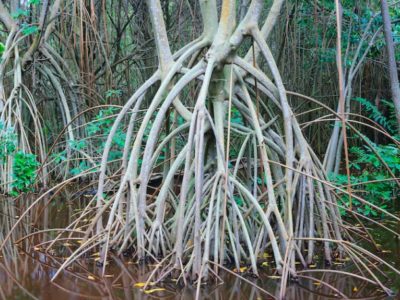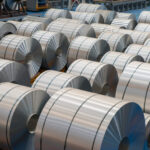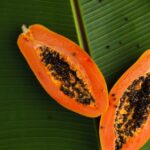Blue carbon ecosystems (BCEs), such as mangrove forests, seagrass meadows, and tidal salt marches, are vegetated coastal ecosystems that accumulate and store large quantities of carbon in their sediments.
Mangrove forests can store at least three times as much carbon as terrestrial tropical forests. Plus, they offer resilience to climate change impacts because the trees and roots protect the shoreline from extreme weather and erosion. However, blue carbon ecosystems are being degraded or destroyed rapidly.
In 2012, the UN Environment Program recognized the importance of blue carbon, stating that “a worldwide transition to a low-carbon, resource-efficient green economy will not be possible unless the seas and oceans are a key part of these urgently needed transformations.”
Growing recognition of the importance of our coastal ecosystems has spurred the development of markets for blue carbon ecosystems. Through these markets, BCE restoration projects generate credits based on the amount of carbon captured and stored. For example, BCE projects reduce greenhouse gas emissions by preventing the loss and degradation of ecosystems and by restoring the ecosystem to increase its carbon dioxide absorption and long-term storage capabilities. And companies that want to offset their carbon emissions buy these credits.
Mangrove projects thus far have been the initial focus of blue carbon projects because there is a greater scientific understanding of the carbon flows and the restoration process. For example, early efforts to restore mangrove forests used mass plantings that often had a high seedling mortality rate (one large-scale study estimates a 51% seedling survival rate). However, research proved that regenerating an area – including restoring the natural flow of the sediment and freshwater to promote tree growth and natural recovery – yields more resilient, functional, and biodiverse mangrove forests.
Although there are financial, practical, and legal hurdles still to work out, these projects are a viable option to help companies achieve their climate targets. And while BCE scientific research is still at an early stage, it is sound. Plus, projects tend to benefit both biodiversity and coastal communities. And carbon markets have already grown to a value of USD 270 billion, putting it on the radar of institutional investors as an investable asset class.
For example, Apple is working with Applied Environmental Research Foundation (AERF) to safeguard the future of 21,000 hectares of mangroves from Alibaug to Mumbai. They are working to create alternative, sustainable industries in the local communities that cultivate and benefit from the biodiversity and resilience of the mangrove ecosystems. In addition, Apple previously worked with Conservation International to protect mangroves in Cispatá Bay in Córdoba, Colombia, along the coast of the Caribbean Sea.
So far, carbon offsets have primarily focused on land-based projects and carbon capture, utilization, and storage. However, the supply of land-based offsets is finite and will likely push up prices and make the investment in blue carbon even more attractive. Soon, BCE projects may be a significant share of the growing demand for offsets.








